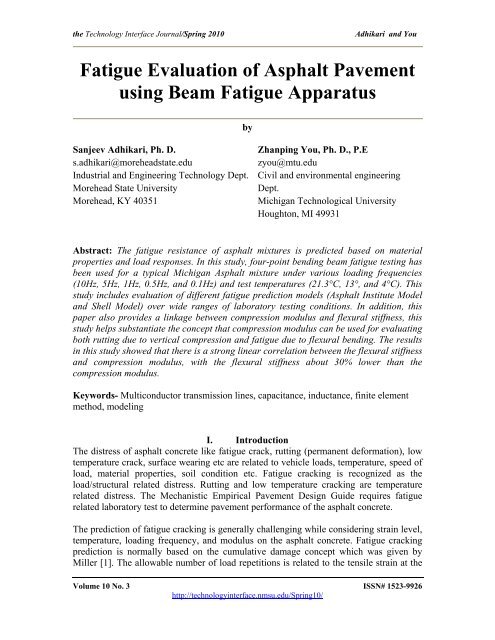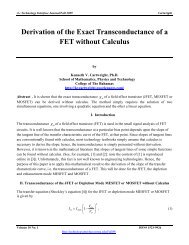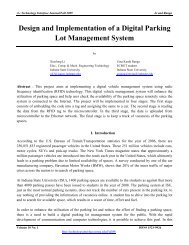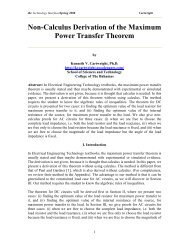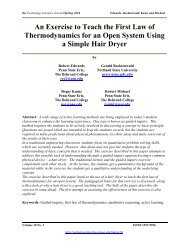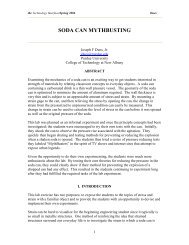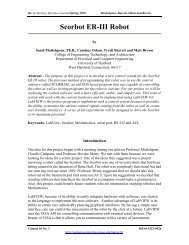Fatigue Evaluation of Asphalt Pavement using Beam Fatigue ...
Fatigue Evaluation of Asphalt Pavement using Beam Fatigue ...
Fatigue Evaluation of Asphalt Pavement using Beam Fatigue ...
Create successful ePaper yourself
Turn your PDF publications into a flip-book with our unique Google optimized e-Paper software.
the Technology Interface Journal/Spring 2010Adhikari and You<strong>Fatigue</strong> <strong>Evaluation</strong> <strong>of</strong> <strong>Asphalt</strong> <strong>Pavement</strong><strong>using</strong> <strong>Beam</strong> <strong>Fatigue</strong> ApparatusbySanjeev Adhikari, Ph. D.s.adhikari@moreheadstate.eduIndustrial and Engineering Technology Dept.Morehead State UniversityMorehead, KY 40351Zhanping You, Ph. D., P.Ezyou@mtu.eduCivil and environmental engineeringDept.Michigan Technological UniversityHoughton, MI 49931Abstract: The fatigue resistance <strong>of</strong> asphalt mixtures is predicted based on materialproperties and load responses. In this study, four-point bending beam fatigue testing hasbeen used for a typical Michigan <strong>Asphalt</strong> mixture under various loading frequencies(10Hz, 5Hz, 1Hz, 0.5Hz, and 0.1Hz) and test temperatures (21.3°C, 13°, and 4°C). Thisstudy includes evaluation <strong>of</strong> different fatigue prediction models (<strong>Asphalt</strong> Institute Modeland Shell Model) over wide ranges <strong>of</strong> laboratory testing conditions. In addition, thispaper also provides a linkage between compression modulus and flexural stiffness, thisstudy helps substantiate the concept that compression modulus can be used for evaluatingboth rutting due to vertical compression and fatigue due to flexural bending. The resultsin this study showed that there is a strong linear correlation between the flexural stiffnessand compression modulus, with the flexural stiffness about 30% lower than thecompression modulus.Keywords- Multiconductor transmission lines, capacitance, inductance, finite elementmethod, modelingI. IntroductionThe distress <strong>of</strong> asphalt concrete like fatigue crack, rutting (permanent deformation), lowtemperature crack, surface wearing etc are related to vehicle loads, temperature, speed <strong>of</strong>load, material properties, soil condition etc. <strong>Fatigue</strong> cracking is recognized as theload/structural related distress. Rutting and low temperature cracking are temperaturerelated distress. The Mechanistic Empirical <strong>Pavement</strong> Design Guide requires fatiguerelated laboratory test to determine pavement performance <strong>of</strong> the asphalt concrete.The prediction <strong>of</strong> fatigue cracking is generally challenging while considering strain level,temperature, loading frequency, and modulus on the asphalt concrete. <strong>Fatigue</strong> crackingprediction is normally based on the cumulative damage concept which was given byMiller [1]. The allowable number <strong>of</strong> load repetitions is related to the tensile strain at theVolume 10 No. 3 ISSN# 1523-9926http://technologyinterface.nmsu.edu/Spring10/
the Technology Interface Journal/Spring 2010Adhikari and Youbottom <strong>of</strong> the asphalt layer. <strong>Fatigue</strong> models are developed to predict the number <strong>of</strong>repetitions at failure <strong>of</strong> asphalt layer. Most <strong>of</strong> the fatigue models are related to thehorizontal tensile strain and stiffness (modulus) <strong>of</strong> the asphalt mixture.The fatigue resistance <strong>of</strong> asphalt mixture is commonly determined by the flexuralbending beam test [2]. A constant haversine loading was applied in an asphalt concretebeam with a number <strong>of</strong> load repetitions to get the failure status <strong>of</strong> the beam. In this paper,fatigue failure is defined as 50% reduction <strong>of</strong> initial stiffness. The reduction <strong>of</strong> stiffnesscan be related to the micro crack that appeared in asphalt concrete. <strong>Beam</strong> fatigue test isused to evaluate the different fatigue models. The four-point beam fatigue test was usedat a constant strain level <strong>of</strong> 400, 300, and 200 micro strains and frequency level <strong>of</strong> 10Hz,5Hz, and 1Hz. The test temperature <strong>of</strong> the beam was 21.3°C, 13°, and 4°C. The numbers<strong>of</strong> cycles measured from laboratory tests are compared with the Shell model and the<strong>Asphalt</strong> Institute model.II. Background on fatigue modelThere are many fatigue models to determine the fatigue life <strong>of</strong> an asphalt specimen. Thesimplest fatigue models considered the fatigue prediction based on either controlled strainmode or controlled stress mode. Equation 1 shows the simplest fatigue models <strong>of</strong>controlled strain mode and equation 2 shows the simplest fatigue models <strong>of</strong> controlledstress mode. The simplest fatigue model does not consider the temperature, modulus, andloading frequency <strong>of</strong> the asphalt pavement.1 kN f k1()t1N f k1()t2k2Where:N f = cycle <strong>of</strong> load to failure t = tensile strain at bottom <strong>of</strong> specimenσ t = applied tensile stressk 1 , k 2 = experimental determined coefficient(1)(2)The coefficient k1 and k2 are determined by fitting a linear regression function to thetesting data. The models require field calibration to provide the in-service fatigue life <strong>of</strong>an asphalt pavement. The calibrated models, which are also called transfer functions,relate to the mechanistically determined responses under repeated loading.There are different fatigue transfer functions that are used by different agencies or basedon different considerations, for example, the Finn model [3], the <strong>Asphalt</strong> Institute Model[4], and the Shell Model [5]. The major role <strong>of</strong> these models is to provide a relationbetween mixture properties, pavement response (strain), and load repetitions to failure.The parameters <strong>of</strong> these models are mainly based on a continuous loading sequence andthe coefficients are determined from empirical data regression. Equations 3 and 4 showthe <strong>Asphalt</strong> Institute Model, and the Shell Model respectively.Volume 10 No. 3 ISSN# 1523-9926http://technologyinterface.nmsu.edu/Spring10/
the Technology Interface Journal/Spring 2010Adhikari and YouNNff 0.0796( t) 0.0685( )t3.2915.671( E )( E0.85412.3631)(3)(4)Where:N f = t =E 1 =cycle <strong>of</strong> load to failuretensile strain at bottom <strong>of</strong> specimen (in/in)asphalt concrete initial flexural modulus (psi)Monismith et al. [6] introduced the fatigue life prediction from initial modulus and tensilestrain <strong>of</strong> the asphalt mixture. Prior to Monismith’s contribution, Pell and Cooper [7]introduced the fatigue model, which was based on the effect <strong>of</strong> the volumetric asphaltcontent and air void content <strong>of</strong> the asphalt mixture.III. ObjectivesThe objectives <strong>of</strong> this study are: 1) to evaluate the existing traditional fatigue predictionmodel which relies on laboratory testing; 2) to develop a relationship between theflexural stiffness and compression modulus <strong>of</strong> asphalt concreteIV. Sample Preparation and TestingThe asphalt mixture was mixed with PG 64-28 binder and had an asphalt content <strong>of</strong>5.50%. The asphalt mixture studied in this research is a 9.5mm Nominal MaximumAggregate Size (NMAS) mixture used in Michigan. For the beam fatigue sample, themixture was first compacted <strong>using</strong> a slab kneading compactor to a target air void <strong>of</strong> 4%,and then cut into a dimension <strong>of</strong> 63mm by 50mm by 380mm. The beam dimensionswere 50mm high, 63mm wide by 385mm long. The illustration <strong>of</strong> compacted and cutsamples is shown in Figure 1. For the compression modulus sample, the mixture wascompacted with a target air void <strong>of</strong> 4%.Figure 1. Illustration <strong>of</strong> compacted and cut samples <strong>of</strong> slab and beamThe asphalt specimen was tested in the beam fatigue apparatus at different strain levels,different frequencies, and different temperatures. The range <strong>of</strong> strain levels was 400, 300Volume 10 No. 3 ISSN# 1523-9926http://technologyinterface.nmsu.edu/Spring10/
the Technology Interface Journal/Spring 2010Adhikari and YouFigure 3. Relationship between compressive modulus and flexural stiffnessb) Comparison <strong>of</strong> <strong>Beam</strong> fatigue <strong>using</strong> fatigue modelThe lab measurement fatigue life data were compared with different fatigue models inthis section. <strong>Fatigue</strong> life was measured at the strain level <strong>of</strong> 400με, 300με, and 200με andfrequency level <strong>of</strong> 10Hz, 5Hz, and 1Hz. Figure 4 shows the flexural stiffness along thestrain level and loading frequencies at 21.3°C. At 10 Hz loading frequency, fatigue life islow at 400με level and fatigue life is exponentially high at 400με. When comparingfatigue life at different loading frequency, 10Hz has low fatigue life compare to 1Hzloading frequency. Figure 5 shows comparison <strong>of</strong> fatigue life along the range <strong>of</strong> strainlevel, loading frequency, and test temperature. Stain level is 200με, 300με, and 400με.Volume 10 No. 3 ISSN# 1523-9926http://technologyinterface.nmsu.edu/Spring10/
the Technology Interface Journal/Spring 2010Adhikari and YouFigure 4. Flexural stiffness <strong>of</strong> asphalt concrete at different strain levels and loadingfrequenciesFigure 5. Comparison <strong>of</strong> <strong>Fatigue</strong> life at different strain level, loading frequency andtemperature at 21.3˚CVolume 10 No. 3 ISSN# 1523-9926http://technologyinterface.nmsu.edu/Spring10/
the Technology Interface Journal/Spring 2010Adhikari and YouThe fatigue life measured from laboratory test was compared with <strong>Asphalt</strong> institute andShell fatigue model. Input parameters <strong>of</strong> the fatigue model were flexural stiffness at 50cycles loading and tensile strain level for the <strong>Asphalt</strong> Institute model and Shell model.Figure 6 shows comparison <strong>of</strong> fatigue life from lab measurement with different fatiguemodels at temperature <strong>of</strong> 21.3°C. When comparing two models from measurement, it wasfound that <strong>Asphalt</strong> Institute model was slightly over-predicted the fatigue life and Shellmodel was slightly under-predicted the fatigue life at a range <strong>of</strong> temperatures and loadingfrequencies.Figure 6. Comparison <strong>of</strong> Lab measurement with <strong>Asphalt</strong> Institute model and shell modelwith different temperature at 21.3˚CVI. Summary and conclusions<strong>Beam</strong> fatigue test was used to evaluate the flexural stiffness and fatigue life <strong>of</strong> the asphaltbeam. The four-point beam fatigue test was used at a constant strain level <strong>of</strong> 400, 300,and 200 micro strains and frequency level <strong>of</strong> 10Hz, 5Hz, and 1Hz. When compared theflexural stiffness with compressive modulus, the flexural stiffness was 30% lower thancompressive modulus. <strong>Beam</strong> fatigue test was also used to evaluate the different fatiguemodels. The number <strong>of</strong> cycle measured from laboratory tests were compared withdifferent fatigue models. It was revealed that fatigue life was low, when the asphalt beamwas tested with high strain level and high loading frequency. <strong>Fatigue</strong> life was high at lowstrain level and low loading frequency. <strong>Fatigue</strong> life is increased with decreasing loadingfrequency. The laboratory results verify that <strong>Asphalt</strong> Institute model and Shell modelwere useful to predict fatigue life at different strain level, loading frequencies and testtemperature.Volume 10 No. 3 ISSN# 1523-9926http://technologyinterface.nmsu.edu/Spring10/
the Technology Interface Journal/Spring 2010Adhikari and YouReferences[1] Miller, M. A., "Cumulative Damage In <strong>Fatigue</strong>." Applied Mechanics, 1945 Vol.12 No. 9[2] AASHTO T 321, Standard Method <strong>of</strong> Test for Determining the <strong>Fatigue</strong> Life <strong>of</strong>Compacted Hot-Mix <strong>Asphalt</strong> (HMA) Subjected to Repeated Flexural Bending,2008, AASHTO, Washington D.C.[3] Finn, F. N., Saraf, C., Kulkarni, R., Nair, K., Smith, W., and Abudllah, A. "TheUse <strong>of</strong> Distress Prediction Subsystems in the Design <strong>of</strong> <strong>Pavement</strong> Structures."Fourth International Conference on the Structural Design <strong>of</strong> <strong>Asphalt</strong> <strong>Pavement</strong>s,1977, University <strong>of</strong> Michigan, 3-38.[5] Shell pavement design manual, asphalt pavements and overlays for road traffic,Shell International Petroleum Company Limited, 1978, London[6] Monismith, C. L., Epps, J. A., and Finn, F. N., "Improved <strong>Asphalt</strong> Mix Design."Association <strong>of</strong> <strong>Asphalt</strong> Paving Technologists, 1985, Vol. 55, Page 347-406.[7] Pell, P., and Cooper, K., "The effect <strong>of</strong> testing and mix variables on the fatigueperformance <strong>of</strong> bituminous materials." Association <strong>of</strong> <strong>Asphalt</strong> PavingTechnologists, 1975, Vol. 44, Page 1-37Volume 10 No. 3 ISSN# 1523-9926http://technologyinterface.nmsu.edu/Spring10/
the Technology Interface Journal/Spring 2010Adhikari and YouSanjeev Adhikari, Ph.D.Dr. Sanjeev Adhikari is assistant pr<strong>of</strong>essor <strong>of</strong> department <strong>of</strong> Industrial and EngineeringTechnology at Morehead State University. He obtained doctoral degree on CivilEngineering from Michigan Technological University at 2008. His research interest issustainable construction, pavement material, asphalt and concrete material.Zhanping You, Ph. D., P.EDr. Zhanping You is associate pr<strong>of</strong>essor <strong>of</strong> Michigan Technological University.Volume 10 No. 3 ISSN# 1523-9926http://technologyinterface.nmsu.edu/Spring10/


